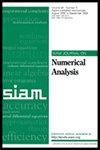Provably Convergent Newton–Raphson Method: Theoretically Robust Recovery of Primitive Variables in Relativistic MHD
IF 2.9
2区 数学
Q1 MATHEMATICS, APPLIED
引用次数: 0
Abstract
SIAM Journal on Numerical Analysis, Volume 63, Issue 3, Page 1128-1159, June 2025.Abstract. A long-standing and formidable challenge faced by all conservative numerical schemes for relativistic magnetohydrodynamics (RMHD) equations is the recovery of primitive variables from conservative ones. This process involves solving highly nonlinear equations subject to physical constraints. An ideal solver should be “robust, accurate, and fast—it is at the heart of all conservative RMHD schemes,” as emphasized in [S. C. Noble et al., Astrophys. J., 641 (2006), pp. 626–637]. Despite over three decades of research, seeking efficient solvers that can provably guarantee stability and convergence remains an open problem. This paper presents the first theoretical analysis for designing a robust, physical-constraint-preserving (PCP), and provably (quadratically) convergent Newton–Raphson (NR) method for primitive variable recovery in RMHD. Our key innovation is a unified approach for the initial guess, carefully devised based on sophisticated analysis. It ensures that the resulting NR iteration consistently converges and adheres to physical constraints throughout all NR iterations. Given the extreme nonlinearity and complexity of the iterative function, the theoretical analysis is highly nontrivial and technical. We discover a pivotal inequality for delineating the convexity and concavity of the iterative function and establish general auxiliary theories to guarantee the PCP property and convergence. We also develop theories to determine a computable initial guess within a theoretical “safe” interval. Intriguingly, we find that the unique positive root of a cubic polynomial always falls within this “safe” interval. To enhance efficiency, we propose a hybrid strategy that combines this with a more cost-effective initial value. The presented PCP NR method is versatile and can be seamlessly integrated into any RMHD numerical scheme that requires the recovery of primitive variables, potentially leading to a very broad impact in this field. As an application, we incorporate it into a discontinuous Galerkin method, resulting in fully PCP schemes. Several numerical experiments, including random tests and simulations of ultrarelativistic jet and blast problems, demonstrate the notable efficiency and robustness of the PCP NR method.
可证明收敛Newton-Raphson方法:相对论MHD中原始变量的理论鲁棒恢复
SIAM数值分析杂志,第63卷,第3期,第1128-1159页,2025年6月。摘要。相对论磁流体力学(RMHD)方程的所有保守数值格式都面临着一个长期存在的艰巨挑战,即从保守变量中恢复原始变量。这个过程包括求解受物理约束的高度非线性方程。理想的求解器应该是“稳健、准确和快速的——这是所有保守的RMHD方案的核心”,正如[S]所强调的那样。C. Noble等人,天体物理学。[J].书刊,2006,第626-637页。尽管经过了30多年的研究,寻找能够保证稳定性和收敛性的有效解仍然是一个悬而未决的问题。本文首次从理论上分析了RMHD中原始变量恢复的鲁棒、物理约束保持(PCP)、可证明(二次)收敛牛顿-拉夫森(NR)方法的设计。我们的关键创新是一种统一的初始猜测方法,这种方法是基于复杂的分析精心设计的。它确保最终的NR迭代一致地收敛,并在所有NR迭代中遵守物理约束。考虑到迭代函数的极端非线性和复杂性,理论分析具有高度的非平凡性和技术性。我们发现了描述迭代函数凹凸性的一个关键不等式,并建立了保证PCP性质和收敛性的一般辅助理论。我们也发展理论来确定一个可计算的初始猜测在一个理论的“安全”区间内。有趣的是,我们发现三次多项式的唯一正根总是落在这个“安全”区间内。为了提高效率,我们提出了一种混合策略,将其与更具成本效益的初始值相结合。提出的PCP NR方法具有通用性,可以无缝集成到任何需要恢复原始变量的RMHD数值方案中,可能会在该领域产生非常广泛的影响。作为应用,我们将其纳入不连续Galerkin方法中,得到了完全PCP方案。包括随机测试和超相对论射流和爆炸问题的模拟在内的几个数值实验表明,PCP NR方法具有显著的效率和鲁棒性。
本文章由计算机程序翻译,如有差异,请以英文原文为准。
求助全文
约1分钟内获得全文
求助全文
来源期刊
CiteScore
4.80
自引率
6.90%
发文量
110
审稿时长
4-8 weeks
期刊介绍:
SIAM Journal on Numerical Analysis (SINUM) contains research articles on the development and analysis of numerical methods. Topics include the rigorous study of convergence of algorithms, their accuracy, their stability, and their computational complexity. Also included are results in mathematical analysis that contribute to algorithm analysis, and computational results that demonstrate algorithm behavior and applicability.

 求助内容:
求助内容: 应助结果提醒方式:
应助结果提醒方式:


